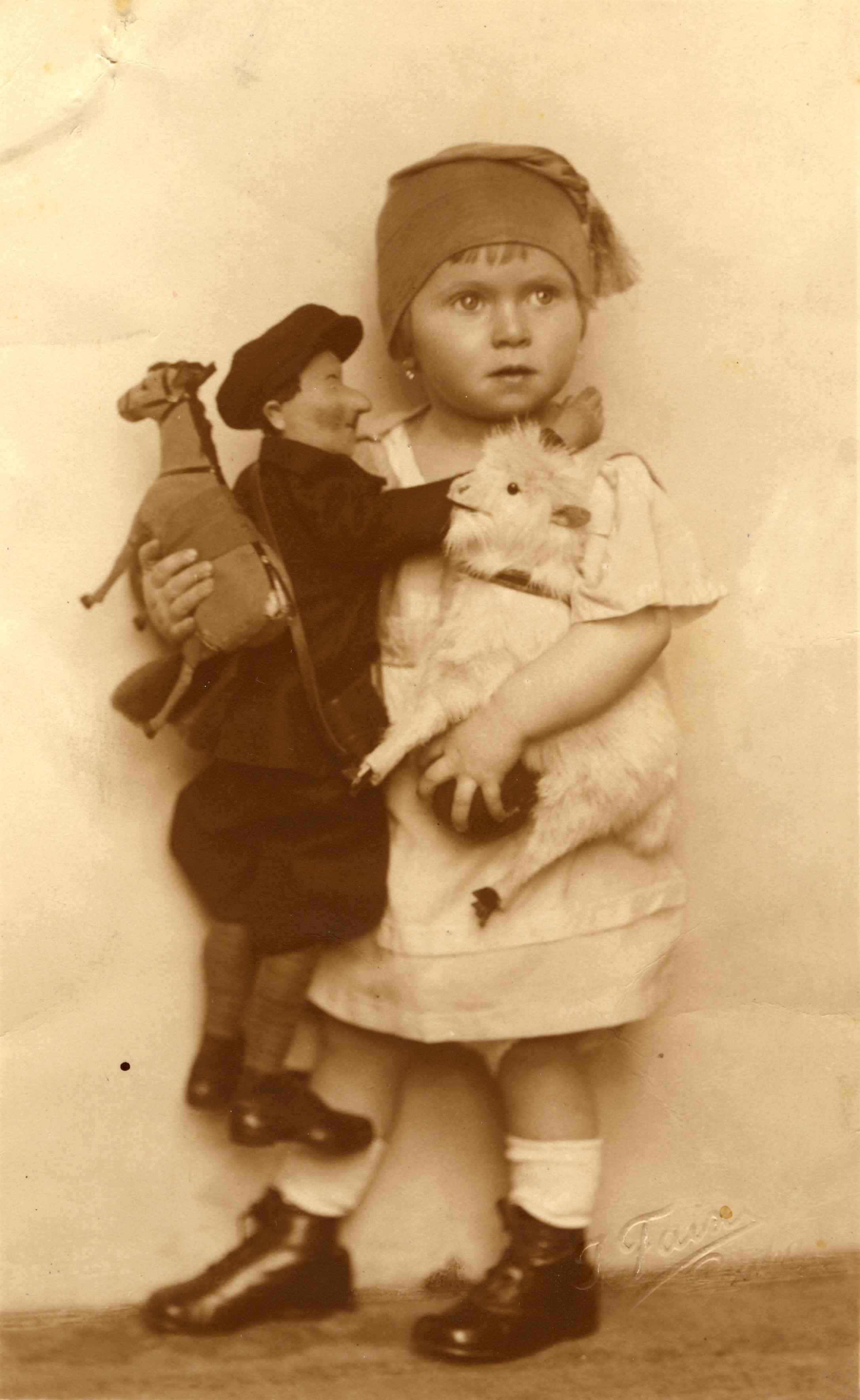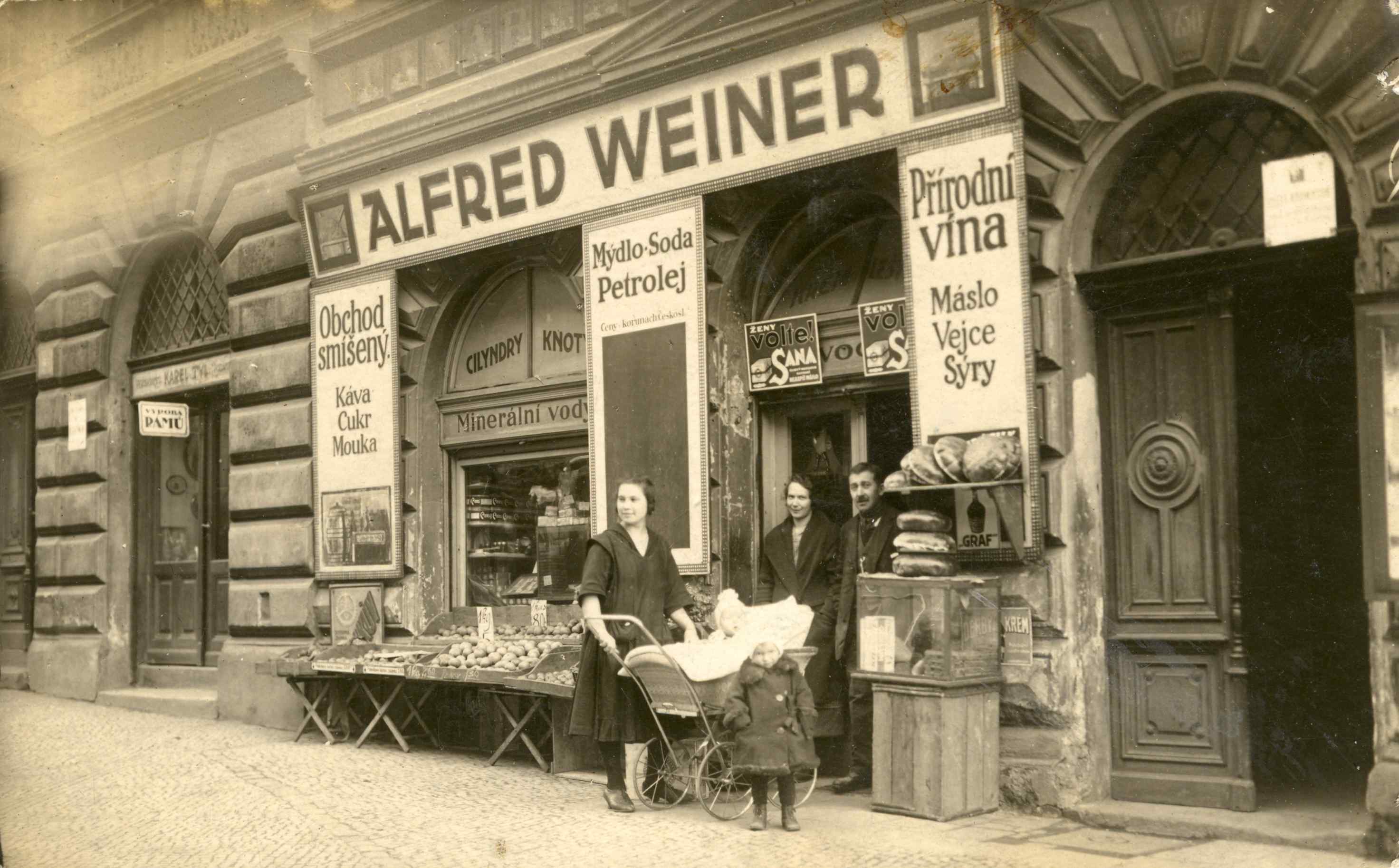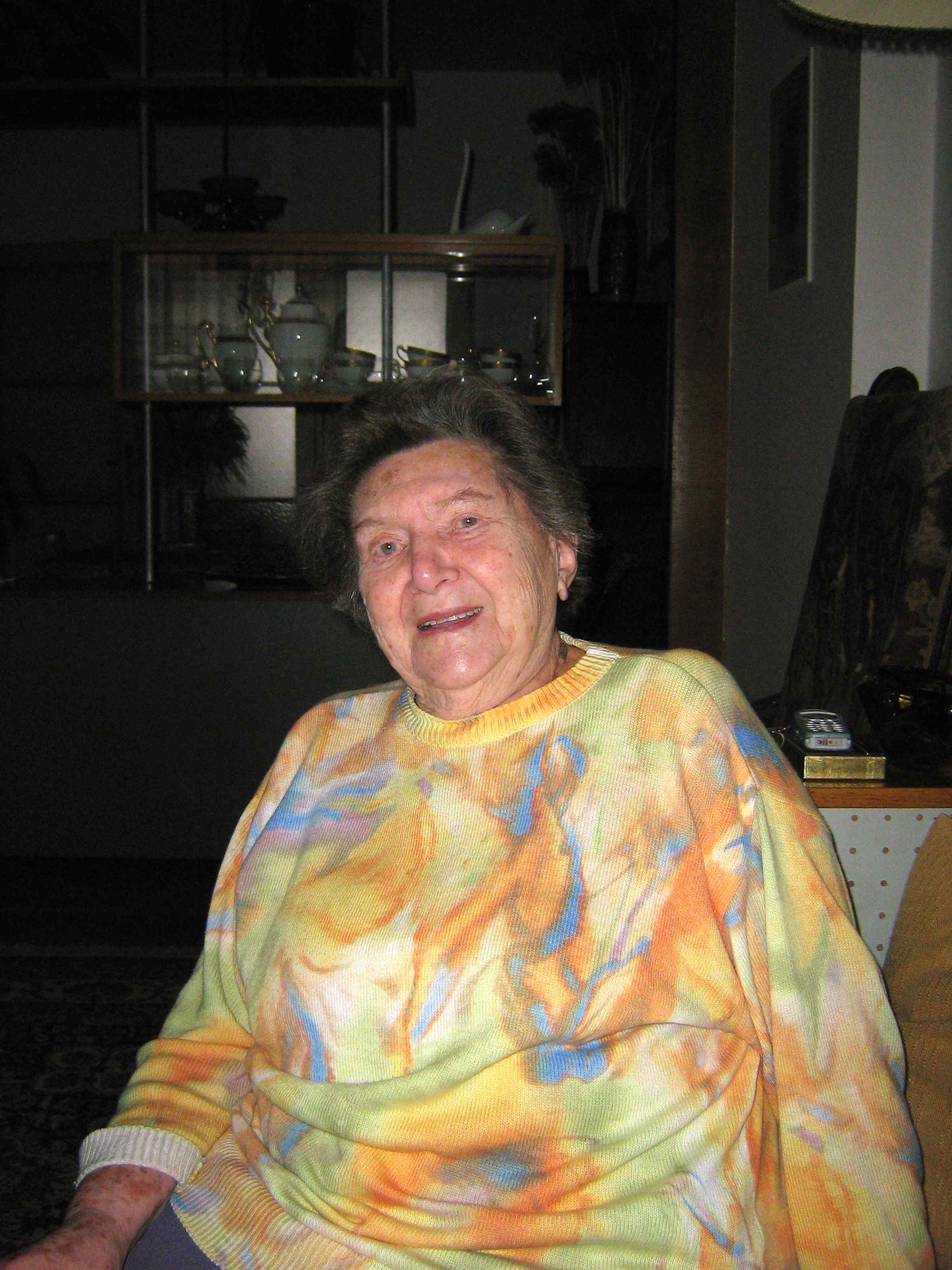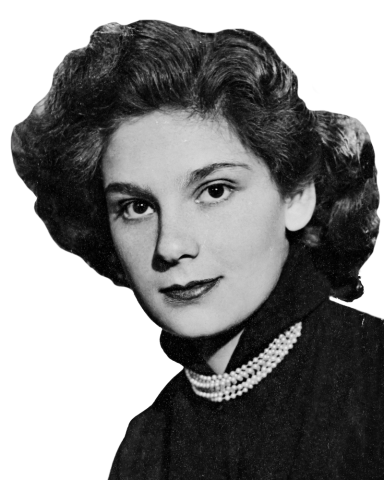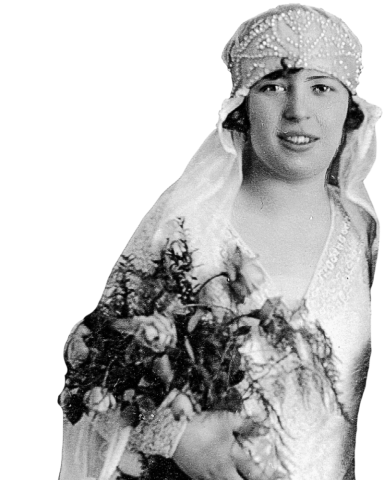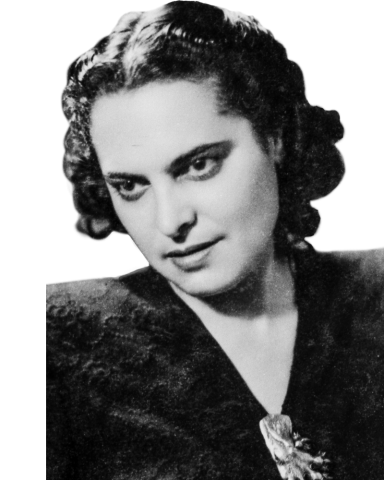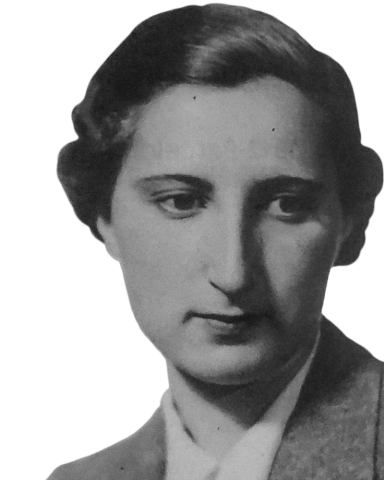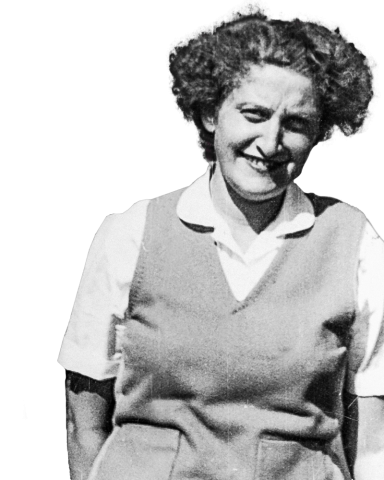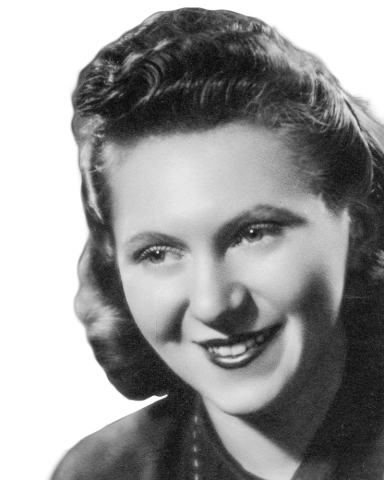
Ludmila Rutarova
Ludmila Rutarova was a Jewish Holocaust survivor from Prague. She went from Terezin through Auschwitz and Bergen-Belsen, returning to Prague, where she established her own family after the war.
Interviewer
Dagmar Greslova
Year of interview
2007
Place of Interview
Prague, Czech Republic
Childhood
Ludmila Rutarova as a child
My mother, Helena Weinerova, née Winternitzova, was born in 1896 in Cernovice, by Tabor. In 1912, my mother's sisters Ema and Marta were going to America. They were in England, waiting for a ship, and in order to pass the time, they went dancing. They were young, wanted to have fun, the dancing kept going, and so they missed the ship. They had no idea how lucky that was, because their ship was the Titanic. That's fate. When their parents found out that the Titanic had sunk, they were desperate, but Ema and Marta wrote home that they'd missed the ship, and so had taken a different one. In the end, they both remained in America.
My father [Alfred Weiner] always liked to talk about how my parents met. In Cernovice my mother knew someone named Emil, they'd been going out together for several years, and it was already clear that they'd be getting married. When Emil came to ask Grandpa for my mother's hand, he was interested in what sort of dowry my mother would get. When my grandfather listed everything she would get, Emil asked whether she would also get a cow for her dowry. To this my grandfather answered that she wouldn't get a cow. My mother was listening behind the door, and when she heard this, she said: 'You wanted a cow? So marry a cow!' and left for Prague. In Prague she met my father, and married him out of spite.
The Weiner family shop
We lived in Prague on Na Morani Street, near Palacky Bridge. We had a servant, Helena. My parents had a general store where they sold various goods: fruit, vegetables, baked goods, butter, eggs, milk, coffee, tea, sugar, sometimes even chickens and geese. During the time of the Protectorate [fn]Protectorate of Bohemia and Moravia: Bohemia and Moravia were occupied by the Germans and transformed into a German Protectorate in March 1939, after Slovakia declared its independence. The Protectorate of Bohemia and Moravia was placed under the supervision of the Reich protector, Konstantin von Neurath. The Gestapo assumed police authority. Jews were dismissed from civil service and placed in an extralegal position. In the fall of 1941, the Reich adopted a more radical policy in the Protectorate. The Gestapo became very active in arrests and executions. The deportation of Jews to concentration camps was organized, and Terezin/Theresienstadt was turned into a ghetto for Jewish families. During the existence of the Protectorate, the Jewish population of Bohemia and Moravia was virtually annihilated. After World War II, the pre-1938 boundaries were restored, and most of the German-speaking population was expelled.
[/fn], we had to close the store and move into one room. Before that we'd been living in the building where our store was, and we had a small apartment.
We were basically a secularized family; we didn't live in any especially religious fashion. We observed Christian Christmas and also used to have a tree. We didn't cook kosher. My father would only go to the Jerusalem Synagogue for the Long Day [Yom Kippur] or New Year [Rosh Hashanah]; I don't even know exactly which of these holidays.
In Prague, starting in Grade 3, I attended the Na Hradek girls' public school on Vysehradska Street. Then I attended business school and finished my last year in a reformed school [fn]Reformed school - is a type of secondary school that developed mainly between the wars in Czechoslovakia. Reformed schools used new teaching methods. The aims, content and methods of teaching are adapted to the needs and interests of the child in order to create a "tailor-made school" that can be of maximum benefit to the child (the so-called principle of adequacy). Because of this focus, this pedagogy is sometimes referred to as the pedagogy of the child.
[/fn]. After school I was employed as a clerk at Tauber&Fisl in Vysocany. I had to leave because the political situation was starting to become unpleasant - as a Jew, I wasn't allowed to be employed as an office worker. My brother Pepik [Josef] wanted to attend a business academy on Resslova Street, but the situation was already bad, so he didn't get in. My father was afraid that he might have to join the army, so they sent my brother to Ringhoffer, to Tatra [fn]Ringhoffer was a Prague German family of entrepreneurs. The Ringhoffer Works was one of the largest industrial plants in Austria-Hungary, producing railway carriages and trams. After the merger with the Kopřivnice wagon factory, the company was called Ringhoffer-Tatra from 1936, and after the Second World War it was nationalised under the name Tatra.
[/fn], to apprentice as an auto mechanic. After the war, he became the youngest master there.
Terezin
During the war, when things got unpleasant, my parents told me to not go to work anywhere. I couldn't work in an office, because no one would take me on. I found a priest, Father Culik, who baptized me, and I became a Catholic. Gradually, various edicts were issued ordering Jews to hand in various things - basically we weren't allowed anything back then; we weren't allowed in the theaters, we weren't allowed in the cinema, we weren't allowed to go to the park, we could only ride in the rear car of the streetcar, and we of course had to wear a star [fn]On September 1, 1941 an edict was issued according to which all Jews having reached the age of six were forbidden to appear in public without the Jewish star. The Jewish star is represented by a hand-sized, six-pointed yellow star outlined in black, with the word 'Jude' in black letters. It had to be worn in a visible place on the left side of the article of clothing. This edict came into force on September 19, 1941. It was another step aimed at eliminating Jews from society.
[/fn].
My brother Josef left in November 1941 on the second transport to Terezin [fn]A ghetto in the Czech Republic, run by the SS. Jews were transferred from there to various extermination camps. The Nazis, who presented Theresienstadt as a 'model Jewish settlement,' used it to camouflage the extermination of European Jews. Thanks to the large number of artists, writers, and scholars in the ghetto, there was an intensive program of cultural activities.
[/fn]. From that time on we didn't have any news of him. I, along with my parents, went on the transport in April 1942. At first, they put us up in the basement of the Kavalir barracks, just on some straw. My father then stayed there, and my mother and I went to the Hamburg barracks. Initially, we were living on the ground floor, where I got sick: I had some sort of flu and spent most of my time in bed. They then moved us to the first floor to room No. 165, where about fifty of us women lived together.
Terezin had a special currency, so-called 'Ghettogeld', which we'd get for doing work. There were a couple of shops in the ghetto where you could get things that had been stolen from people that had arrived in Terezin. There were also grocery stores, but all you could get in them was vinegar and mustard, basically nothing.
The entire time in Terezin, I worked in agriculture, in the so-called 'Landwirtschaft.' We'd always assemble, and initially we used to hoe carrots, thin out beets, cultivate tomatoes, shuck beans and all sorts of other things. In the winter, we made straw mats for greenhouses. In Terezin I got to know Regina, a girl I worked with in the staff garden where we cultivated cucumbers and other things. We used to steal the cucumbers, but I didn't know how to steal much, I was bad at it. Regina, on the other hand, was clever: she'd always pluck one for me and tell me, 'Just stick it in your bra!' So I'd stick it in my bra and was able to smuggle something into the ghetto for my parents.
In Terezin, I sang for Rafael Schächter [fn]Rafael Schächter (1905-1945) was a Czechoslovak pianist and initiator of various artistic and cultural events in the Theresienstadt concentration camp. He organized the activities to keep up the prisoners’ courage to live . Like Ludmila Rutarova, Schächter was deported to Auschwitz, where he died in 1945 during the evacuation of the concentration camp on a death march.
[/fn]in 'The Bartered Bride' [fn]Opera by Czech composer Bedrich Smetana (1824-1884)
[/fn], in 'The Kiss,' in 'The Czech Song,' and in the 'Requiem' by Giuseppe Verdi. Initially we practiced in a cellar, where the piano was [fn]The piano had been smuggled to Theresienstadt by Rafael Schächter. The choir practiced in a cellar for noise-cancelling.
[/fn]. I also saw Hans Krasa's 'Brundibar' [fn]The children's opera Brundibar was created in 1938 for a contest announced by the Czechoslovak Ministry of Schools and National Education. It was composed by Hans Krasa based on a libretto by Adolf Hoffmeister. The first performance of Brundibar - by residents of the Jewish orphanage in Prague - wasn't seen by the composer. He had been deported to Terezin. Not long after him, Rudolf Freudenfeld, the son of the orphanage's director, who had rehearsed the opera with the children, was also transported. This opera had more than 50 official performances in Terezin. The idea of solidarity, collective battle against the enemy and the victory of good over evil today speaks to people the whole world over. Today, the opera is performed on hundreds of stages in various corners of the world.
[/fn].
Auschwitz
Before I left Terezin, there was a Red Cross visit being planned, and we had to do so-called 'Verschönerung,' or beautification. Terezin was to be decorated to fool the Red Cross delegation [fn]At the end of 1943, when word spread of what was happening in the Nazi camps, the Germans decided to allow an International Red Cross investigation committee to visit Theresienstadt. In preparation, more prisoners were deported to Auschwitz in order to reduce congestion in the ghetto. Dummy stores, a café, a bank, kindergartens, a school, and flower gardens were put up to deceive the committee.
[/fn]. However, I wasn't there to see the Red Cross visit. I was in Terezin from April 1942 until May 1944, when I left with my brother for Auschwitz. My mother and father left on the first May transport for the so-called family camp [fn]The Auschwitz complex consisted of three main camps, of which Auschwitz II, or Birkenau, comprised a camp for families. On 8th September 1943, 5,000 Jews were transported to Birkenau from the Terezin (Theresienstadt) ghetto and put up in a special section. Women, men and children lived in separate barracks but were allowed to move freely on this site. The family camp for the Czech Jews was part of the Nazi propaganda for the outside world. Prisoners were not organized into work-commandos; they were allowed to receive packages and were encouraged to write letters. Despite this special treatment more than 1,000 people died in the family camp during its six months of existence. On March 9, 1944, all those still alive in the camp were gassed.
[/fn], and my brother and I left on the third one in May 1944. When the train stopped in Auschwitz, it was already dark, and we could hear them bellowing, 'Raus, raus.' We got out and were ordered to leave all our bags there; they told us that we'd get them later. Of course, we never saw our bags again. The Poles were very cruel and beat us with sticks. We lined up five abreast, walked along and saw the sign 'Arbeit macht frei' [German for 'work shall set you free'] above our heads. Some Pole walked along with us who told us that if any of us knew how to write well, we'd have it good in Auschwitz.
In Auschwitz, they tattooed us, and I got No. A 4603. I'd counted the line as it walked in front of me, and positioned myself so that the sum of my number was 13. I'm superstitious, and I said to myself that if the sum of my number's digits would be the unlucky 13, I'd survive the war. Then they assigned us to blocks. The block leader yelled at us that we were all to go outside and leave everything inside. I'd noticed that the block leader had been talking to a friend of mine with whom I'd worked in the 'Landwirtschaft' in Terezin, Dina Gottliebova. I had absolutely no idea of Dina's status in the camp. I went over to Dina and told her that the block leader had ordered us to leave all our things inside - Dina told me to go back and take everything with me. She had privileged status: Dina was the lover of 'Lagerältester' [camp elder] Willy, thanks to which she saved herself and her mother from the gas. Dina was a swell girl; before the war, she'd attended art school in Brno, and could draw beautifully. Mengele hired her to draw Roma in the 'Gypsy camp' for his 'research' [fn] Josef Mengele (1911-1979) was an SS physician who conducted inhumane, and often deadly, medical experiments in Auschwitz-Birkenau concentration camp. Being one of the most infamous figures of the Holocaust, he was also called the “Angel of Death”. Auschwitz survivors often remember his presence at the ramp of the camp, where he conducted the “selection” of inmates upon their arrival in Auschwitz-Birkenau: “Selecting” meant deciding who would be sent to forced labor and who would be directly sent to death in the gas chambers, which targeted mostly children, older people, and disabled people. Despite being one of 50 physicians in Auschwitz-Birkenau who were regularly present at the ramp, Mengele is by far the most notorious of them, appearing in a great number of testimonies given by Auschwitz survivors. Researchers suggest that his present picture in media and historical research also impacted survivors’ memory, leading them to remember Mengele’s face as a symbolized trauma caused by the forced split from their family members upon arrival in Auschwitz-Birkenau. After the war, Josef Mengele fled to South America, where he died in 1979.
[/fn]. Dina also drew for the children in the children's block. It was from Dina Gottliebova that I found out that the Nazis were murdering people in gas chambers in Auschwitz. When I found out about the gas, I cried for three days.
I was in the FKL - Frauen-Konzentrationslager [women's concentration camp] where they shaved our entire bodies but left me my hair. We also went through several selections there. As we walked Mengele would be sitting there and pointing: left, right. Mengele needed to pick out a thousand women for work, and he picked my mother and me. We also had to undergo a gynecological examination to check if we were pregnant. Because I was so skinny that there was no way anyone could've thought I was pregnant, I avoided the exam. They sent us to go bathe; we were, of course, afraid that instead of water, gas would come out of the showers, but in the end it really was water. We had to take everything off, and they told us that we'd pick our things up after washing. But instead of our own things, we were issued horrible rags and high-heel shoes! So I then left for work in Hamburg in high-heel shoes!
When my mom and I left for Hamburg in July 1944, my dad stayed in Auschwitz because he was already 65. Saying goodbye to dad and Auntie Zofie was awful because I already suspected how it would end. Dad was calming me down, and said, 'I've got my life behind me, you've got yours ahead of you, I'm glad that you're going with Mom.' My father didn't survive; he went into the gas that same year, 1944. The worst thing is that my dad never believed in the gas. When they told me that they were burning people there [in Auschwitz], I cried terribly, and my dad kept telling me to not believe it, that it's not possible. I guess the poor man had to find out the hard way…
Forced labor in Hamburg
There were about fifty of us women in the wagon to Hamburg. It was July, sweltering, and we had one pail for a toilet and one pail with water. There were so many of us that I remember that in the evening it wasn't possible for all the women to lie down. My mom ate a piece of salami and got horribly sick.
We arrived in Hamburg, at a place named Freihafen. It was an old granary, a ramp and train tracks. We didn't know what was to become of us, where they'd take us, nothing. From there we'd be transported to various plants like Eurotank and RTL, and for cleanup work, basically wherever we were needed. We cleared away bombed-out buildings, chipped the old mortar off of bricks and put them at the side of the road because bricks cleaned up in this manner were then taken away for use in the construction of new buildings. Some people in Hamburg were very kind; I remember that once a German woman called out to me from some building, asking me to come over to her. At first I was afraid to go into the building, but she handed me a loaf of bread and told me to split it with the girls. Another time a person came along, and when he saw what kind of shoes we were working in, he brought over a wheelbarrow of shoes, for us to pick some more suitable ones from. Because in Auschwitz I'd been issued high-heel shoes, which really weren't suitable for work!
Bergen-Belsen
After one air raid that destroyed the buildings in which we'd been living, they transported us by train to another camp. During the train trip, I got my first slap from an SS woman. Because the SS woman wanted very much to learn to sing the song 'Prague Is Beautiful' in Czech, which for some reason she liked. It annoyed me the way she was constantly singing, and so I cracked something like 'stupid cow' and right away got a good slap. They took us to some train station. We had no idea where we were, and it was already twilight. At dawn we arrived at the camp. It was still half-light; suddenly, I glimpsed a huge dark mountain beside me. I looked more carefully and realized that they were shoes. A huge mountain of shoes... We'd arrived in Bergen-Belsen [fn]Concentration camp located in northern Germany. Bergen-Belsen was established in April 1943 as a detention camp for prisoners who were to be exchanged with Germans imprisoned in Allied countries. Bergen- Belsen was liberated by the British army on 15th April, 1945. The soldiers were shocked at what they found, including 60,000 prisoners in the camp, many on the brink of death, and thousands of unburied bodies lying about.
[/fn].
The conditions in Bergen-Belsen were catastrophic. Getting even a little bit to eat was terribly difficult; the accommodations were atrocious. There was no water, we couldn't wash, the toilets were atrocious. Because there weren't enough toilets for so many people, the men dug out these deep ditches where people used to go, there you saw men's, women's bottoms and you didn't give a damn.
The camp was liberated on the 15th of April, 1945. After liberation, the English distributed canned pork. My mother confiscated it from me, told me that we wouldn’t eat that, and only allowed me to eat crackers and powdered milk. We went to have a look around the camp. I found an office full of money from all sorts of countries, but it didn't even occur to me to take some of it because I didn't know what I'd do with it in Bergen-Belsen. For me, clothing and a bite of food were of more value than money. In Bergen-Belsen, I saw so many horrors …
Post-war
My mother and I left Bergen-Belsen for home in July 1945. We traveled several days by train. When we were arriving in Moran, people were staring at us, and everyone was shouting something at us. Mrs. Schneiderova called out, 'Liduska, your typewriter is at our place!' Everyone in Moran was terribly kind to us. Pepik was already in Prague; he'd returned from Schwarzheide on a death march [fn]In fear of the approaching Allied armies, the Germans tried to erase all evidence of the concentration camps. They often destroyed all the facilities and forced all Jews regardless of their age or sex to go on a death march. This march often led nowhere, and there was no specific destination. The marchers received neither food nor water and were forbidden to stop and rest at night. It was solely up to the guards how they treated the prisoners, if and what they gave them to eat, and they even had in their hands the prisoners' life or death. The conditions during the march were so cruel that this journey became a journey that ended in the death of most marchers.
[/fn]. Of our entire family, only I, my mother, brother, my cousin Inka and one distant cousin from Jindrichuv Hradec survived.
After the war, when I returned from the camps, I had no documents. Back then I wrote to the [Jewish] Community for them to send me a copy of my birth certificate. But after I'd had myself baptized in 1939, they deleted me from the Community. So I wrote to the priest Father Culik in Nizebohy who'd baptized me before the war. He sent me all my records right away and sent me a very beautiful, nice letter, saying how happy he was that I survived the war.
Ludmila Rutarova's wedding
In Prague, I met my future husband, Karel Rutar. Life is full of coincidences; Karel was actually almost the first man that I saw in Terezin! After the war I found out that he'd been the head carpenter, and that some problem had happened there that he didn't cause, but they punished him for being the boss and letting it happen. The SS soldier punished him by making him go outside at night, in the winter, naked, and pouring cold water on him. He then gave him such a slap that it punctured his eardrum, and for the rest of his life Karel was hard of hearing in one ear. Karel's sister Ela and his mother were murdered in Auschwitz.
Karel and I were married in 1946, and I moved in with him, to his place in Vrsovice, where I live to this day. In 1947, we had a daughter, Iva, and at first I was at home with her. Then my mother babysat her for some time, while I went to do office work for the Teply Company. After the war, we weren't well-off, so my husband and I both worked. In 1949, our son Josef was born. I found a job at Sazka, a betting agency, where I worked three days a week, so my salary would at least cover the rent. Karel worked for the Milk and Fats Association, the Ministry of Food Industries, and then for Orionka [The Orion Chocolate Co.].
My mother died in 1964; in her old age she suffered from advanced Alzheimer's disease. My husband died in 1966 at the age of 49, of leukemia. I was left alone with two children. In 1968, my brother Pepik immigrated with his family to America, where he died in 2005. After Pepik emigrated, I was no longer allowed to travel outside of the country on business. I was allowed to visit the countries of the socialist bloc as a tourist on my personal passport. I didn't make it over to visit him until I was retired, in 1976 and then again in 1987. As a retiree, I was allowed to go to America because the Communists would have liked to get rid of retirees. I remember that I was amazed at how many goods were available in America; back then, in Czechoslovakia there was almost nothing, so for me it was a tremendous contrast. But I have to say that I never considered emigrating.
Ludmila Rutarová in her flat in Prague
When the children were small, I decided to have the number tattooed on my forearm removed. In the summer, when I'd be wearing a short-sleeved dress, I'd often notice people looking at my forearm and then whispering amongst each other. It used to happen that they'd turn to me and begin to feel terribly sorry for me and keep repeating what a poor thing I was, how I must have suffered during the war. I don't want anyone's pity. When I arrived at the dermatology ward, the lady doctor asked me what was ailing me. I told her that I'd like to have a tattoo removed. She looked at me with an annoyed expression and began berating me, 'And why did you get a tattoo in the first place? You could have realized that one day you'd change your mind, and now all you're doing is making more work for me!' So I told her that I hadn't exactly been overly enthused about getting this tattoo, and if I'd have had a choice, I would definitely have not let them give me a tattoo. Then I rolled up my sleeve. The doctor immediately did an about-turn and began to apologize profusely; the poor thing had not realized what sort of tattoo it was.
After the war, I was in Auschwitz with my son to have a look; there are only chimneys left behind. Occasionally I participated in Holocaust remembrances, and to this day I attend events put on by the Terezin Initiative [fn]In the year 1991, the former prisoners of various concentration camps met and decided to found the Terezin Initiative (TI), whose goal is to commemorate the fate of Protectorate (Protectorate of Bohemia and Moravia) Jews, to commemorate the dead and document the history of the Terezin ghetto. Within the framework of this mission, TI performs informative, documentary, educational and editorial activities. It also financially supports field trips to the Terezin Ghetto Museum for Czech schools.
[/fn].
